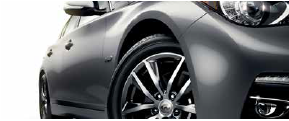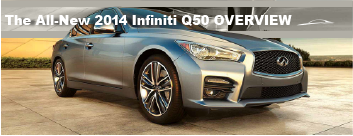
The all-new Q50 sports sedan has distinctive design features and new technology, and reflects Infiniti’s new naming convention — all sedans will be designated Q and all SUVs QX. Each model designation with its number will reflect its size and place in the lineup rather than its engine size.
Exterior
The Q50’s distinctive design features new styling and technology, and in addition it is available in a hybrid version. Although its wheelbase is identical to the outgoing G37’s, it is actually 2 inches wider, its overall length is slightly longer, and the overall height is less than a half inch shorter than the G37 sedan. You will note right away its exterior design is radically different, mimicking the larger M37 sedan. The b-pillar has been pushed slightly forward to allow for easier entry into the back. Its exterior design creates a coefficient of drag that is a remarkably low 0.26. Other notable exterior features are its standard LED headlights, the addition of running lights (first time for Infiniti USA), and taillights. The Q50’s Sport trim level has a more streamlined front-end design and a trunk that is 18.0 cubic feet, which is large for the class, and 14.1 cubic feet in the hybrid version.
Interior
The interior highlights mark an upgrade over the previous G sedans. The new Q50 offers a driver-centric cabin that features two touch-screens, located in the center of the instrument panel, that can work independently or in tandem. The new Infiniti InTouch™ can provide moving map navigation on the top screen while a destination address can be inputted in the lower screen. With the integration of hands-free phone, entertainment and smart phone apps, the Q50 puts communication with the outside world within easy reach.
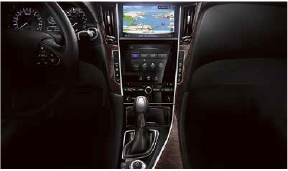
Infiniti InTouch™
Infiniti InTouch™ controls the heater and air conditioner, audio, navigation system (if so equipped), InTouch Apps, Bluetooth® Hands-free phone, etc. All of these systems can be controlled using the upper or lower dual touch-screen displays, the Infiniti controller, the menu buttons, or the steering-wheel switch.
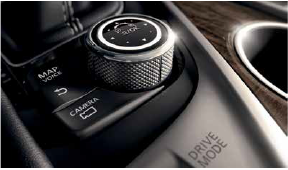
Powertrain
The Q50 has the G sedan’s standard 328-horsepower, 3.7-liter V6, a seven-speed automatic transmission and rear- or all-wheel drive. The Infiniti Drive Mode Selector now adds a Custom setting to the Snow, Eco, Standard and Sport modes. Personal Mode allows the driver to assign his or her own selection of engine/transmission, steering effort and response calibrations to a single mode; the other modes are predetermined. Steering wheel shift paddles are optional.
The new hybrid powertrain uses a 3.5-liter HEV V6 and produces approximately 360 HP hybrid system net power combining the gasoline engine and the electric motor. This approach is similar to that in the M sedan; it provides more power than the standard gas-only engine along with higher mileage and adopts the idle engine stop system.
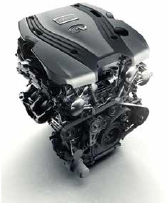
The Infiniti Q50’s optional new Infiniti Direct Adaptive Steering™, which is a by-wire steering system, provides advanced control of the Q50’s tire angle and steering inputs. This new steering system can transmit the driver’s steering inputs to the wheels faster than a mechanical system. The steering ratio and power assist can also be customized to suit the driver with four different steering settings. The Active Lane Control™ uses a camerabased lane marker detection system, enabling drivers to make fewer steering corrections on highways by reducing the difference between the vehicle’s direction and the lane direction.
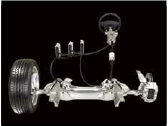
Brakes
Braking is provided by 4-wheel power-assisted vented disc brakes with a 4-wheel Anti-lock Braking System (ABS), Electronic Brake force Distribution (EBD) and Brake Assist. Also available are sport brakes with upgraded rotors, 4-piston front calipers and 2-piston rear calipers.
The Electronically-Driven Intelligent Brake system on the Hybrid model uses both regenerative braking and conventional hydraulic braking systems.
Suspension
Precise handling is provided by the 4-wheel independent multi-link suspension. The front is a single pivot double-wishbone design, while the revised rear design utilizes a multi-link design with coil springs, and Dual Flow Path® shock absorbers, and increased camber stiffness and improved ride comfort. The suspension features extensive use of lightweight aluminum components, along with front and rear stabilizer bars. A sporttuned suspension is available with Sport models.
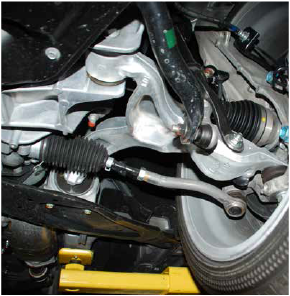
Safety
Standard safety features include the federally mandated anti-lock brakes. Other features include driver and passenger front-impact air bags, front seat-mounted side-impact air bags, and roof-mounted curtain side-impact air bags.
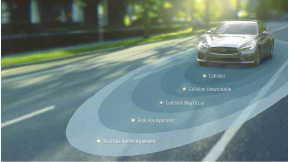
The Q50 offers a host of safety features designed to help prevent collisions. They include Predictive Forward Collision Warning with Forward Emergency Braking, Blind Spot Warning, Backup Collision Intervention, Lane Departure Prevention and Active Lane Control. Active Lane Control uses a camera to help the driver keep a straight path in his lane in case of crosswinds and road imperfections.
The Q50 comes with run-flat tires in all its variations, which makes for additional cargo trunk space. 17-inch wheels are standard on the Q50, but the Sport trim levels are available with 19-inch wheels.
